Effects of magnetic stimulation on urodynamic stress incontinence refractory to pelvic floor muscle training in a randomized sham-controlled study
Abstract
Objective
The aim of the present study was to evaluate the effect of magnetic stimulation on urodynamic stress incontinence refractory to pelvic floor muscle training in a randomized sham-controlled study.
Methods
Female patients with urodynamic stress incontinence who had not been cured by pelvic floor muscle training were randomly assigned at a ratio of 2 : 1 to either active treatment or sham treatment for 10 weeks. The randomization was made using magnetic cards for individuals indicating active or sham stimulation. The primary endpoint was changes in the number of incontinence episodes/week, with secondary endpoints of the degree of incontinence (in g/day; determined using the pad test), the total score on the International Consultation on Incontinence Questionnaire – Short Form (ICIQ-SF), the ICIQ quality of life (QOL) score, and the abdominal leak point pressure (ALPP) on urodynamic study.
Results
Although 39 patients were enrolled in the study, 9 dropped out, leaving a total patients for analysis (18 in the active treatment group, 12 in the sham treatment group). The number of incontinence episodes/week, the degree of incontinence, total ICIQ-SF score, ICIQ-QOL score, and ALPP were significantly improved after active treatment compared with baseline (all P < .05), but did not change significantly after sham treatment. There was a significant intergroup difference with regard to changes from baseline in the ICIQ-SF and ALPP in favor of the active treatment group (P < .05). There were no significant differences in any other parameters between the 2 groups. Treatment-related adverse events were not found in both groups.
Conclusion
Magnetic stimulation was effective in treating urodynamic stress incontinence.




